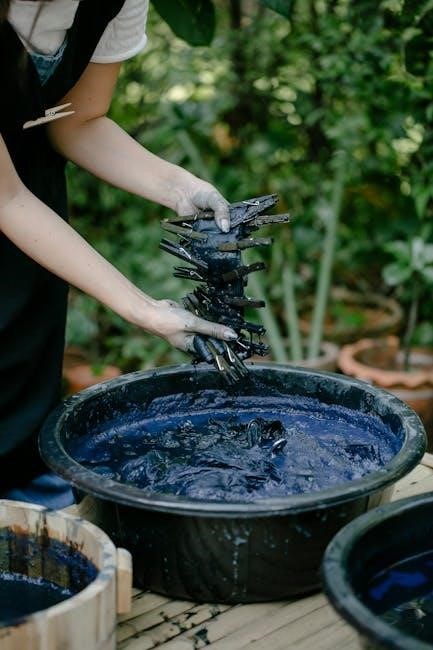Tie-dye washing is a vibrant, creative process requiring careful preparation and attention to detail. This technique involves folding, tying, and dyeing fabrics to achieve unique patterns. Proper washing ensures colors stay bold and fabrics remain intact. Tie-dye has become a popular DIY trend, blending artistry with practical care steps. Follow printable guides for best results and enjoy your handmade designs.
1.1 Overview of Tie-Dye Techniques
Tie-dye techniques involve folding, tying, or binding fabrics to create unique patterns before dyeing. Common methods include the bullseye, spiral, and shibori. Each technique requires precise folding to achieve desired designs. For example, the bullseye involves pinching fabric into a circle and tying it, while the spiral requires twisting fabric into a coil. Shibori, a Japanese method, uses intricate binding with threads or clips. These techniques ensure that dyes penetrate unevenly, producing distinctive, vibrant patterns. Proper folding and binding are crucial for avoiding color bleeding and ensuring bold results. Techniques vary in complexity, from simple folds for beginners to intricate designs for experienced crafters. Following step-by-step guides helps achieve professional-looking tie-dye effects. Printable instructions often include visuals to simplify these creative processes, making tie-dye accessible to all skill levels.
1.2 Importance of Proper Washing
Proper washing is crucial for maintaining the vibrancy and durability of tie-dye fabrics. Incorrect washing techniques can lead to color fading, uneven patterns, or fabric damage. The first wash is especially important, as it removes excess dye that hasn’t fully bonded with the fabric. Using cold water and color-safe detergents helps preserve colors and prevent bleeding. Hot water and harsh chemicals can degrade dyes and weaken fabric fibers. Additionally, washing tie-dye items separately from other clothes initially ensures colors don’t transfer. Following specific care instructions, such as avoiding fabric softeners and soaking garments in soda ash solutions, enhances color retention. Proper washing not only extends the life of tie-dye fabrics but also maintains their unique, artistic appeal. Printable guides often emphasize these steps to help users achieve the best results and enjoy their handmade designs for years.
1.3 Brief History of Tie-Dye
Tie-dye, an ancient textile art, has roots in Asia, Africa, and Latin America. The technique involves folding, twisting, or pleating fabric and binding it with thread or rubber bands before dyeing. In Japan, “shibori” techniques date back to the 8th century, while in India, “bandhani” has been practiced for over 500 years. African cultures also used tie-dye for symbolic designs. The method gained global popularity in the 1960s as part of the hippie movement, symbolizing rebellion and creativity. Tie-dye became a staple in fashion, representing individuality and artistic expression. Today, it remains a beloved craft, with modern adaptations using synthetic dyes and simplified processes. The art form’s enduring appeal lies in its ability to create unique, handmade patterns. Printable guides now make it accessible for everyone to experiment with tie-dye, ensuring its legacy continues to inspire future generations.
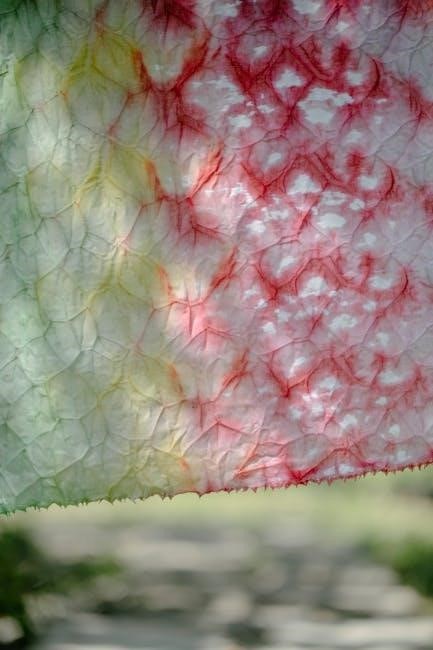
Preparation for Washing Tie-Dye Fabrics
Preparing tie-dye fabrics involves gathering materials like gloves, buckets, and mild detergent. Soak fabrics in soda ash solution to fix colors. Protect hands and workspace.
2.1 Materials Needed for Washing
For washing tie-dye fabrics, essential materials include mild detergent, cold water, and gloves to protect hands. A washing machine or large bucket is necessary for soaking. Rubber bands and plastic wrap are used during the dyeing process to create patterns. Soda ash solution helps fix colors before washing. Separate laundry bags prevent dye transfer to other clothes. Optional items like disposable gloves and old towels can aid in protecting surfaces. Ensure all materials are ready to maintain color vibrancy and fabric integrity during the washing process.
2.2 Pre-Treatment with Soda Ash

Pre-treating tie-dye fabrics with soda ash is crucial for achieving vibrant colors. Soda ash, also known as sodium carbonate, fixes the dye onto the fabric, preventing colors from fading during washing. To prepare the solution, mix 1 cup of soda ash with 1 gallon of warm water. Submerge the folded and tied fabric in this mixture, ensuring all areas are saturated. Allow the fabric to soak for 6-8 hours or overnight, then rinse thoroughly with cold water before dyeing. This step ensures the dye adheres evenly and maintains its intensity. Gloves and a dust mask are recommended when handling soda ash to avoid skin and respiratory irritation. Proper pre-treatment is essential for professional-looking results and long-lasting colors.
2.3 Separating Colors Before Washing
Separating colors before washing ensures vibrant hues remain distinct and prevents unwanted blending. After tie-dyeing, sort garments by color intensity and fabric type. Dark and bright colors should be washed separately from lighter shades to avoid dye transfer. Whites and neutrals, in particular, need protection from potential bleeding. Using color-safe laundry bags can add an extra layer of security. Additionally, consider the fabric type; delicate materials may require separate handling. Sorting not only preserves color clarity but also extends the life of your tie-dye creations. This step is especially important for newly dyed items, as initial washes carry the highest risk of color bleeding. By organizing your laundry thoughtfully, you maintain the unique, artistic appeal of your tie-dye designs.
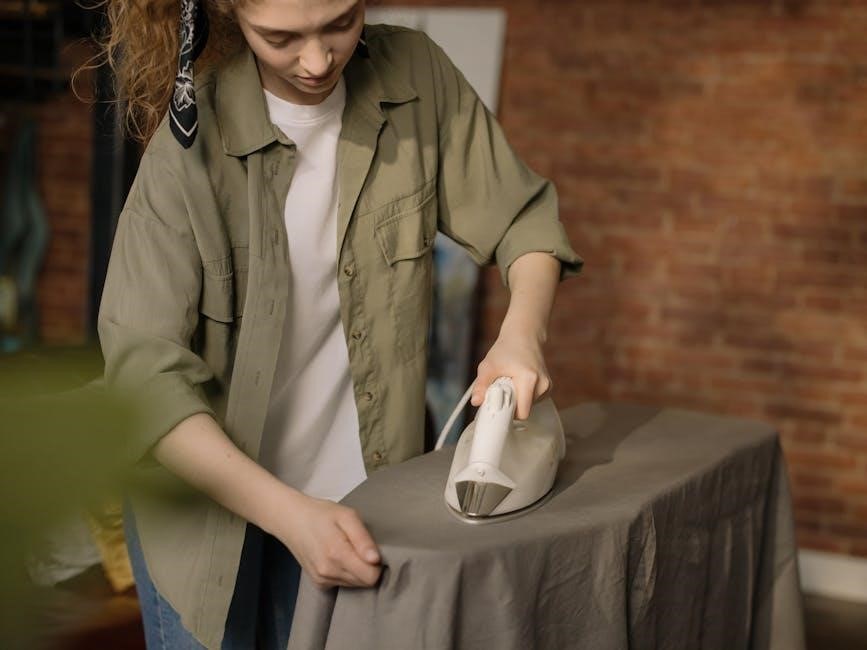
Washing Instructions for Tie-Dye
Washing tie-dye fabrics requires gentle care to preserve vibrant colors and patterns. Use cold water, mild detergents, and avoid harsh chemicals. Hand washing is ideal, but a machine with a gentle cycle works too. Check care labels for specific instructions to maintain your unique designs.
3.1 Hand Washing Steps
Hand washing is the best method to preserve tie-dye colors and patterns. Start by filling a sink or large container with cold water and add a small amount of mild detergent. Gently submerge the tie-dye fabric, ensuring it is fully covered. Let it soak for about 10-15 minutes to loosen excess dye. Use your hands to gently agitate the water, being careful not to scrub or wring the fabric, as this can damage the material or cause colors to bleed. Rinse thoroughly with cold water until the rinse water runs clear. Gently squeeze out excess water without wringing. Repeat if necessary. Avoid using fabric softeners, as they can affect color vibrancy. Lay the fabric flat or hang it to air dry, ensuring it retains its shape and color integrity. This method ensures your tie-dye design stays vibrant and long-lasting.
3.2 Machine Washing Guidelines
Machine washing tie-dye fabrics requires careful attention to preserve colors and patterns. Use a large capacity washing machine to avoid overloading, which can cause friction and color bleeding. Set the machine to a gentle cycle with cold water to protect the dyes. Add a mild detergent, avoiding fabric softeners or bleach, as these can dull colors. For extra protection, place the tie-dye item in a mesh laundry bag before washing. Avoid washing tie-dye fabrics with other clothes, especially light-colored items, to prevent color transfer. If unsure, run a test wash with a small, inconspicuous piece. After the cycle, remove the garment promptly and air dry. Machine drying is not recommended, as heat can damage the fabric and fade colors. Follow these guidelines to maintain the vibrancy and integrity of your tie-dye creations.
3.3 Avoiding Color Bleeding
To prevent color bleeding in tie-dye fabrics, start by washing them separately from other clothes, especially light-colored items. Use cold water, as hot water can cause dyes to bleed. Add a small amount of vinegar to the wash water to help set the colors. Avoid using harsh detergents or bleach, as these can weaken the dye and cause fading. Gently agitate the fabric during washing to minimize friction, which can lead to color transfer. For machine washing, place the tie-dye item in a mesh laundry bag for added protection. After washing, rinse thoroughly with cold water until the runoff is clear. Do not soak the fabric for extended periods, as this can loosen the dye. Air drying is recommended, as machine drying can cause colors to bleed due to heat and friction. By following these steps, you can preserve the vibrancy and integrity of your tie-dye design.
3.4 First Wash Tips
For the first wash, gently rinse the tie-dye fabric under cold water to remove excess dye. Avoid soaking for too long, as this can cause colors to bleed. Use a mild detergent without fabric softeners or bleach, as these can weaken the dye. If using a washing machine, place the fabric in a mesh laundry bag and select a gentle cycle with cold water. Do not wash tie-dye items with other clothes to prevent color transfer. After washing, rinse thoroughly until the water runs clear. Air drying is recommended to preserve the colors and prevent fading. If ironing is needed, use a low heat setting and avoid direct contact with the dyed areas. Following these steps ensures the colors stay vibrant and the fabric remains intact.

Drying and Aftercare
Air drying is recommended to preserve colors and prevent fading. Avoid machine drying and direct sunlight. Store tie-dye items separately in a cool, dry place to maintain vibrancy.
4.1 Air Drying vs. Machine Drying
Air drying is the preferred method for tie-dye fabrics as it prevents color fading and fabric shrinkage. Machine drying, especially on high heat, can cause colors to bleed and patterns to distort. When air drying, lay the garment flat or hang it in a shaded area to avoid direct sunlight, which can also fade colors. Remove any rubber bands or ties before drying to ensure even evaporation of moisture. For machine drying, if necessary, use a low heat setting and a gentle cycle. However, air drying is always the safer option to maintain the integrity and vibrancy of the tie-dye design. Proper drying ensures long-lasting results and preserves the unique, handmade quality of the fabric.
4.2 Ironing Tie-Dye Fabrics
Ironing tie-dye fabrics requires care to preserve the vibrant colors and unique patterns. Always iron inside out to protect the design from direct heat damage. Use a low heat setting and avoid steam, as moisture can cause colors to bleed. Allow the fabric to air dry completely before ironing, as dampness can lead to fading. Ironing while the fabric is slightly damp can help remove wrinkles but be cautious not to scorch the material. For delicate fabrics, place a pressing cloth or parchment paper between the iron and the fabric to prevent direct contact. Never iron over rubber bands or tied sections, as this can create creases or damage the dye. Proper ironing techniques ensure the tie-dye design remains intact and maintains its original appeal.
4.4 Storage Tips
Proper storage of tie-dye fabrics is essential to maintain their vibrant colors and unique patterns. Store garments in a cool, dry place away from direct sunlight, which can cause fading. Avoid folding items for extended periods, as creases can damage the dye. Instead, hang tie-dye fabrics or roll them neatly to prevent wrinkles. Use breathable storage bags or cloth covers to protect against dust and moisture. Keep tie-dye items separate from other clothes to avoid color transfer. For long-term storage, consider using acid-free tissue paper to wrap delicate fabrics. Clean garments before storing to prevent stains from setting in. By following these tips, your tie-dye creations will remain fresh and colorful for years to come. Proper storage ensures your handmade designs stay as vibrant as the day they were created.
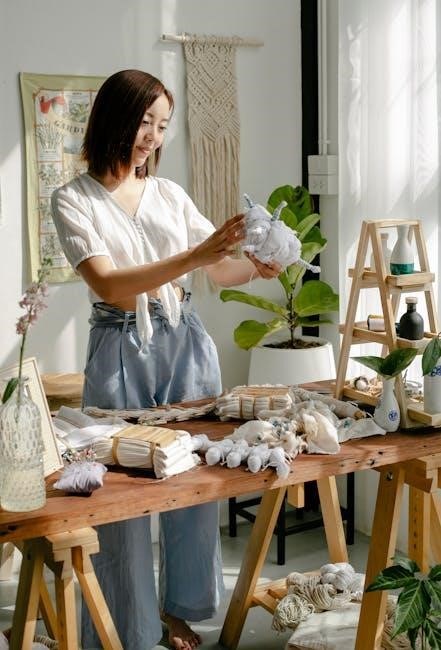
Tips for Preserving Colors
Use color-safe detergents, cold water, and avoid harsh chemicals to preserve tie-dye colors. Turn garments inside out before washing and avoid fabric softeners to maintain vibrancy. Air dry whenever possible.
5.1 Using Color-Safe Detergents
Using color-safe detergents is crucial for preserving tie-dye colors. These detergents are specifically formulated to minimize color bleeding and fading, ensuring your designs remain vibrant wash after wash. Choose detergents labeled as “color-safe” or “for colored fabrics” to protect your creations. Avoid using regular or harsh detergents, as they can strip colors and damage the fabric. For the first wash, consider using a detergent designed for hand-dyeing processes, as it gently locks in colors. Always follow the detergent’s instructions for proper dosage to avoid over-saturation, which can harm the fabric. By investing in the right detergent, you can enjoy your tie-dye pieces for years to come, maintaining their unique and artistic appeal. This step is essential for both hand-washed and machine-washed items, ensuring long-lasting color retention and fabric integrity. Using color-safe detergents is a simple yet effective way to preserve the beauty of your tie-dye creations. Regular use will keep your garments looking fresh and vibrant, making every wash a worry-free experience. Over time, consistent use of color-safe products will prevent the dyes from deteriorating, ensuring your tie-dye designs stay as striking as the day they were made.
5.2 Cold Water Washing
Cold water washing is essential for preserving the vibrancy and integrity of tie-dye fabrics. Washing in cold water prevents colors from fading or bleeding, ensuring your designs stay bold and intact. Hot water can cause dyes to break down and run, which is especially true for handmade or hand-dyed items. Before washing, turn your tie-dye garment inside out to protect the outer layer from friction and abrasion. Use a gentle cycle with cold water and a color-safe detergent to maintain the fabric’s quality. For hand washing, rinse thoroughly with cold water until the excess dye is removed. Avoid soaking in hot water, as it can weaken the color bonds. Regular cold water washing will extend the life of your tie-dye creations, keeping them looking fresh and vibrant for years to come. This simple step is crucial for maintaining the artistic appeal of your handmade designs.
5.3 Avoiding Harsh Chemicals
Avoiding harsh chemicals is crucial for maintaining the vibrancy and longevity of tie-dye fabrics. Chemicals like bleach, fabric softeners, and heavy-duty detergents can weaken color bonds and cause dyes to fade or bleed. Instead, opt for mild, color-safe detergents that gently clean without damaging the fabric or altering the colors. Pre-treating with soda ash before washing helps fix the dyes and reduces the need for harsh chemicals. When washing, skip fabric softeners, as they can leave a residue that dulls the colors. For hand-washing, use a gentle soap specifically designed for hand-dyed or delicate items. By avoiding harsh chemicals, you preserve the intricate patterns and ensure your tie-dye creations remain vibrant for years to come. Always check the care label for specific recommendations tailored to your fabric type.
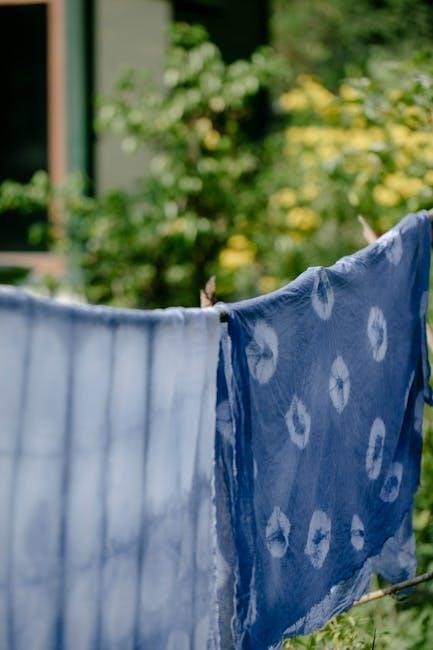
Common Mistakes to Avoid
Common mistakes include over-washing, using harsh detergents, and not following pre-treatment steps. These errors can lead to faded colors and damaged fabrics, ruining your tie-dye designs.
6.1 Over-Washing
Over-washing is a common mistake that can cause tie-dye colors to fade quickly. Excessive washing strips the fibers of their vibrancy, leading to dull designs. It’s important to wash tie-dye fabrics only when necessary and avoid using hot water frequently. Using a gentle detergent and cold water helps preserve the colors. Additionally, washing tie-dye items separately from other clothes can prevent friction that might lead to color bleeding. Always check the care label for specific instructions, as some dyes may require special handling. By minimizing wash cycles and using the right techniques, you can maintain the brilliance of your tie-dye creations for a longer period. This ensures your unique designs remain vibrant and intact, preserving the artistic effort put into each piece.
6.2 Using Wrong Detergents
Using the wrong detergents can significantly damage tie-dye fabrics and cause colors to fade rapidly. Harsh chemicals in regular detergents can strip the dyes from the fabric, leading to dull and washed-out designs. To preserve vibrant colors, it’s essential to use mild, color-safe detergents specifically designed for hand-dyed or tie-dye fabrics. Avoid using fabric softeners, bleach, or harsh stain removers, as these can weaken the fabric and disrupt the dye; Always check the detergent label for suitability with dyed fabrics. Some dyes may require special care, so it’s crucial to follow the recommendations provided with your dye kit. By using the right cleaning products, you can maintain the integrity and longevity of your tie-dye creations, ensuring they remain vibrant and visually striking for years to come. Proper detergent selection is a key step in preserving the beauty of your unique designs.
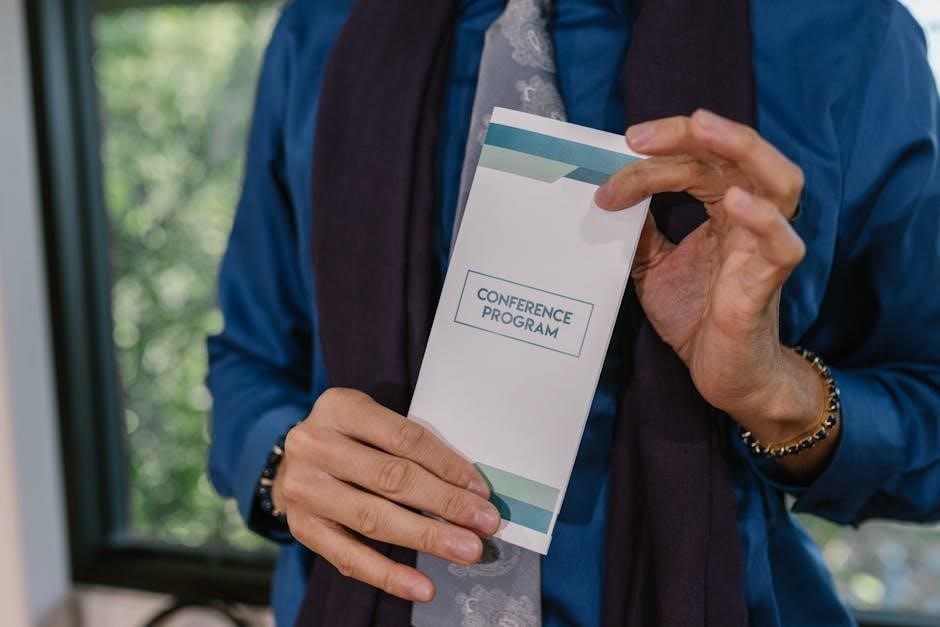
Troubleshooting
Troubleshooting tie-dye washing issues involves addressing common problems like color fading or uneven dye distribution. Always check for detergent compatibility and proper washing techniques to resolve issues effectively.
7.1 Fixing Faded Colors

Faded colors on tie-dye fabrics can be restored by re-dyeing or using color-enhancing detergents. Start by washing the garment in cold water with a color-safe detergent. If fading persists, consider reapplying the dye following the original tie-dye instructions. Avoid using harsh chemicals or hot water, as they can further damage the colors. For minor fading, vinegar added to the rinse cycle can help stabilize the dyes; Always test a small area first to ensure the fix doesn’t damage the fabric. Proper care and gentle washing practices will help maintain vibrant colors and extend the life of your tie-dye creations.
7.2 Correcting Wash Errors
If colors bleed or fade excessively during washing, immediate action can help restore vibrancy. Rinse the garment in cold water to stop further color loss. Re-wash using a color-safe detergent, avoiding fabric softeners. For minor bleeding, soak the fabric in a solution of cold water and white vinegar before re-washing. Avoid hot water, as it accelerates fading. If errors occur during the first wash, such as insufficient rinsing, repeat the rinse cycle thoroughly. Harsh chemicals should be avoided to prevent further damage. Correcting wash errors requires gentle handling and careful detergent selection. Always test a small area first to ensure the fix won’t harm the fabric. Proper care can often mitigate wash errors and preserve the tie-dye design’s integrity.
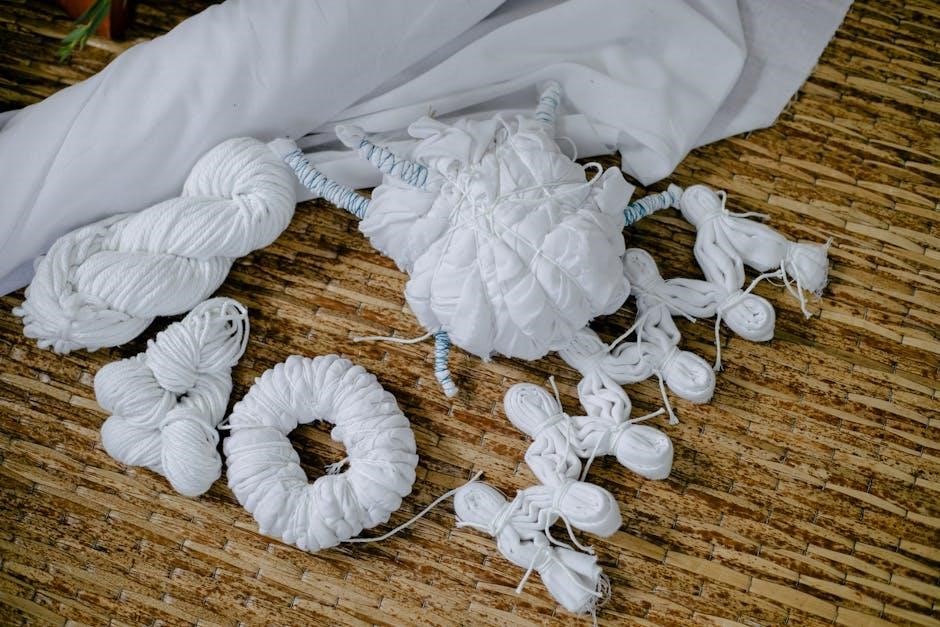
Printable Guide
A printable tie-dye washing guide offers step-by-step instructions, ensuring vibrant colors and fabric integrity. Perfect for sharing or keeping handy, it simplifies the care process.
8.1 Step-by-Step Washing Guide
Start by turning your tie-dye garment inside out to protect the design. Use cold water and a mild detergent without fabric softeners. Gently hand wash or use a delicate machine cycle. Avoid soaking for too long to prevent color fading. Rinse thoroughly until water runs clear, then remove excess moisture without wringing. Lay flat to air dry or tumble dry on low. Separate from other clothes for the first few washes. For best results, follow these steps to maintain vibrant colors and fabric integrity. Print this guide for easy reference and share with others who love tie-dye!
8.2 Care Instruction Cards
Printable care instruction cards are essential for maintaining tie-dye fabrics. Include key steps like washing inside out, using cold water, and avoiding harsh detergents. Add tips for air drying and ironing. Use visuals for clarity and include storage advice to prevent fading. Design cards with a tie-dye theme for a personalized touch. Ensure instructions are concise and easy to follow. Distribute these cards with your handmade or purchased tie-dye items to help owners preserve their vibrant designs. This ensures longevity and keeps colors fresh. Make them downloadable for convenience and shareable for wider use. A well-designed card enhances the value of your tie-dye creations, making them a thoughtful addition for any buyer or gift recipient.
